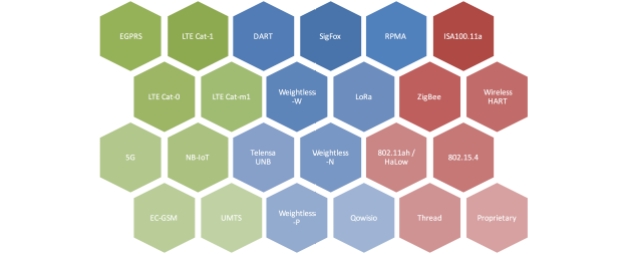 IoT use case are fragmented with different requirements. To match these requirements, a number of IoT connectivity solutions are available including wide-area low-power (LPWA), cellular wireless technologies (EGPRS, UMTS, LTE of different varieties), and short range technologies adapted to cover wide areas through mesh networking (ZigBee, WirelessHART, etc.) or extension of point-to-multipoint technologies (e.g. 802.11ah/HaLow). Each of these technology spaces is crowded with options, so which will survive and which will die out?
IoT use case are fragmented with different requirements. To match these requirements, a number of IoT connectivity solutions are available including wide-area low-power (LPWA), cellular wireless technologies (EGPRS, UMTS, LTE of different varieties), and short range technologies adapted to cover wide areas through mesh networking (ZigBee, WirelessHART, etc.) or extension of point-to-multipoint technologies (e.g. 802.11ah/HaLow). Each of these technology spaces is crowded with options, so which will survive and which will die out?

IoT Connectivity Technologies. [Source: Xona Partners]
- Spectrum regulations which impact performance.
- Total cost of ownership of IoT connectivity networks.
- Performance parameters such as range of coverage, capacity, power consumption, multicast, firmware upgrade and other such features.
- Business models, ecosystem development, standardization, and other critical parameters.
Our analysis showed that certain technologies like Weightless-W and Cat-0 will fall by the wayside. Weightless-W is operates in TV white space spectrum which is only available in 4 countries: USA, Canada, UK and Singapore. Moreover, interference from broadcast stations is a challenge in addition to the regulatory environment surrounding the reorganization of the band in the US. The support for Weightless-W is small, especially as the Weightless SIG recently released the ‘P’ standard which targets unlicensed spectrum in ISM and SRD bands which is a very attractive technology.
As for Cat-0, the difference in performance from Cat-1 will put pressure on the technology especially where hardware upgrades are required at the base station. In looking at vendor roadmaps and product availability, we think the market will stay with Cat-1 until Cat-m1 becomes available.
The myriad of options raises very interesting questions: how will LPWA and LTE compete against each others and against other technologies? Where will each play a role and on which technologies will the market settle? The picture will become more clear within the next 4 years; or maybe it will not!
*For more information, please contact me.